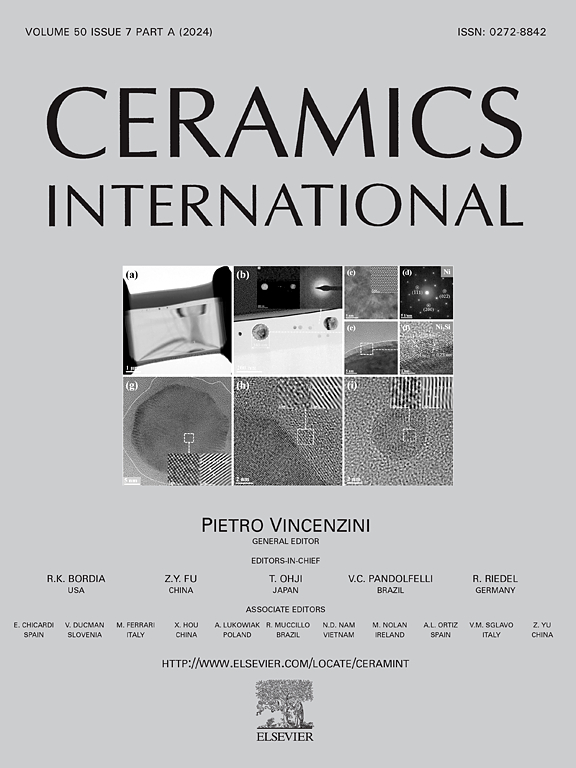Sonochemical synthesis of luminescent Nd2O3 nanoparticles and optimization of NIR luminescence through precursor selection and annealing process
IF 5.6
2区 材料科学
Q1 MATERIALS SCIENCE, CERAMICS
引用次数: 0
Abstract
A novel approach to synthesize neodymium oxide nanoparticles with enhanced emission at 1056 nm, utilizing a bioreduction-sonochemical process using tannic acid is presented. The precursors and postprocessing techniques were systematically investigated to improve light emission due to transitions among the inter-electronic energy levels associated with Nd3+. An extensive analysis was performed on the characteristics presented by the phosphors obtained using various precursor reactives including Nd(NO3)3, NdCl3, NaOH, KOH, and different annealing treatments. TEM micrographs revealed finely tuned nanoparticles, in the range of 5–60 nm in diameter, enveloped in tannic acid residues; consequently, agglomerations of nanoparticles between 60 and 170 nm were self-assembled measured by DLS. PXRD and Raman spectroscopy confirmed the formation of Nd2O3, along with subproducts such as NaNO3, KNO3, NaCl, KCl, and distinctive surface groups, depending on the specific synthesis process studied. Significantly, luminescence measurements demonstrated a remarkable enhancement in signal intensity and quality. To avoid luminescence quench, anneal treatment was used; however, the optimization of the annealing processes was achieved through TGA studies. A self-assembly mechanism is proposed to elucidate the formation process of these neodymium oxide nanoparticles.
发光纳米Nd2O3的声化学合成及前驱体选择和退火工艺优化近红外发光
提出了一种利用单宁酸生物还原-声化学工艺合成氧化钕纳米粒子的新方法,该方法在1056 nm处具有增强发射。系统地研究了前驱体和后处理技术,以改善与Nd3+相关的电子间能级之间的跃迁引起的发光。采用不同的前驱物,包括Nd(NO3)3、NdCl3、NaOH、KOH,以及不同的退火处理,对所得荧光粉的特性进行了广泛的分析。TEM显微图显示,直径在5-60 nm范围内的纳米颗粒被单宁酸残基包裹;因此,在60 ~ 170 nm之间的纳米粒子团块是通过DLS测量自组装的。PXRD和拉曼光谱证实了Nd2O3的形成,以及根据特定合成过程产生的子产物如NaNO3、KNO3、NaCl、KCl和不同的表面基团。值得注意的是,发光测量显示了信号强度和质量的显著增强。为避免光猝灭,采用退火处理;然而,退火工艺的优化是通过热重分析来实现的。提出了一种自组装机制来解释这些氧化钕纳米颗粒的形成过程。
本文章由计算机程序翻译,如有差异,请以英文原文为准。
求助全文
约1分钟内获得全文
求助全文
来源期刊

Ceramics International
工程技术-材料科学:硅酸盐
CiteScore
9.40
自引率
15.40%
发文量
4558
审稿时长
25 days
期刊介绍:
Ceramics International covers the science of advanced ceramic materials. The journal encourages contributions that demonstrate how an understanding of the basic chemical and physical phenomena may direct materials design and stimulate ideas for new or improved processing techniques, in order to obtain materials with desired structural features and properties.
Ceramics International covers oxide and non-oxide ceramics, functional glasses, glass ceramics, amorphous inorganic non-metallic materials (and their combinations with metal and organic materials), in the form of particulates, dense or porous bodies, thin/thick films and laminated, graded and composite structures. Process related topics such as ceramic-ceramic joints or joining ceramics with dissimilar materials, as well as surface finishing and conditioning are also covered. Besides traditional processing techniques, manufacturing routes of interest include innovative procedures benefiting from externally applied stresses, electromagnetic fields and energetic beams, as well as top-down and self-assembly nanotechnology approaches. In addition, the journal welcomes submissions on bio-inspired and bio-enabled materials designs, experimentally validated multi scale modelling and simulation for materials design, and the use of the most advanced chemical and physical characterization techniques of structure, properties and behaviour.
Technologically relevant low-dimensional systems are a particular focus of Ceramics International. These include 0, 1 and 2-D nanomaterials (also covering CNTs, graphene and related materials, and diamond-like carbons), their nanocomposites, as well as nano-hybrids and hierarchical multifunctional nanostructures that might integrate molecular, biological and electronic components.
 求助内容:
求助内容: 应助结果提醒方式:
应助结果提醒方式:


